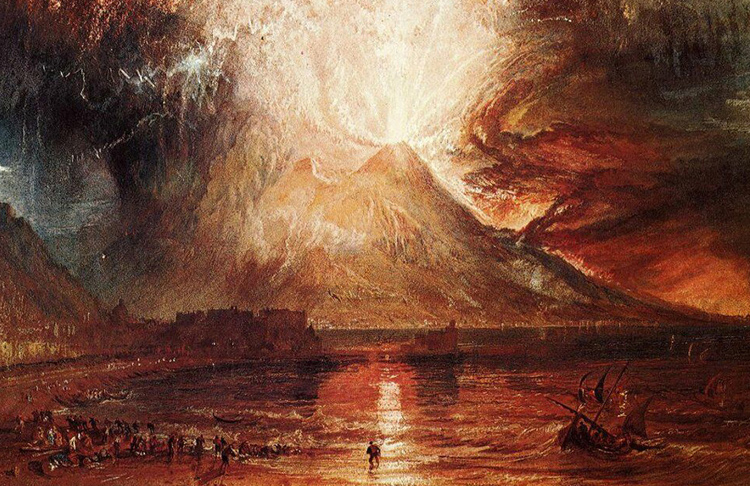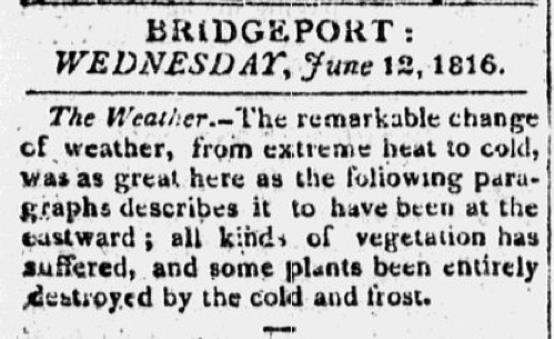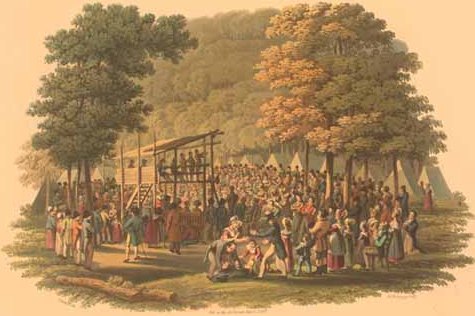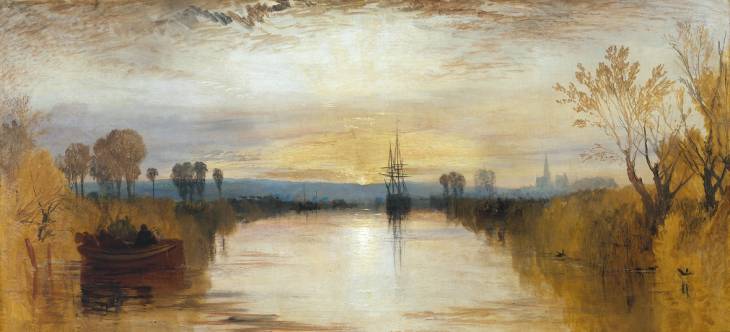A Gloomy and Tedious Period: Learning from 1816
As winter came to an end in 1816, the inhabitants of northern Vermont looked forward to spring, as do many inhabitants of New England and the northeastern United States. Every year, the winds warmed and the recently thawed earth was dug into and filled with seed. The climate provides a sense of cyclical stability. The weather patterns were fairly standard: a long, troubling winter eventually broke and made way for the spring planting season, followed by the eventual return of summer. The year of 1816, however, broke the cycle, upending daily life as it was known, leading to population shifts, and ultimately contributing to significant new socio-cultural production.
The seeds planted in the cool soil did not sprout like they normally did that spring. Many frustrated New England farmers re-planted their crops and still had minimal growth. Concern set in across the northeastern United States, where communities confronted the reality that without these spring crops, they would risk starvation the coming fall and winter months. Their livestock would suffer. Benjamin Harrison, a farmer living in Bennington, VT, wrote, “I well remember the 7th of June…dressed throughout with thick woolen clothes and an overcoat on. My hands got so cold that I was obliged to lay down my tools and put on a pair of mittens.”[1] In Vermont alone, 15,000 people left the state to head west for greener pastures. Many headed west to upstate New York, where they had the same problems: pathetic corn, dry soil, and long periods of drought. The entire northeast was affected, and heading west seemed to be the only way to find better land. The Danville North Star reported the “melancholy weather” on June 15, 1816:
Some account was given in last week’s issue of the unparalleled severity of the weather. It continued without any essential amelioration, from the 6th to the 10th instant—freezing as hard five nights in succession as it usually does in December…. Saturday morning the weather was more severe than it generally is during the storms of winter. It was indeed a gloomy and tedious period.
The year of 1816 was dubbed “The Year Without Summer,” and had other colloquially acceptable and equally haunting names such as “The Summer That Never Was”, “Poverty Year”, and (most disturbing yet) “Eighteen Hundred and Froze to Death.” This weather was triggered by the explosion of Mt. Tambora, which had exploded on the other side of the world over a year before and wreaked havoc across the world.

Depiction of Mt. Tambora eruption via mounttambora.com
On April 10, 1815, Mt. Tambora, located on the island of Sumbawa in what we now know as Indonesia, erupted in the largest volcanic eruption in modern history (by a long shot). The blast itself went eighteen miles into the sky and released twenty-four cubic miles of ash, pumice, and gas into the atmosphere. The Mt. Tambora eruption expelled 150 times more ash than the explosion of Mount St. Helen in 1980,[2] creating consequences that affected nearly all parts of the world. In the immediate geographic region, the earthquakes that accompanied the eruption created savage tsunamis that shook the surrounding Java Sea, flooding people’s homes and ruining farm land. The local devastation killed 10,000 people almost immediately: the ash fell fast and hard, and the debris tarnished the quality of fresh water for the inhabitants of the island. An additional 82,000 people would die worldwide from the far reaching effects of Mt. Tambora, driving the total deaths from this singular event to over 92,000 individuals.
This initial impact came quickly and many of the island’s inhabitants did not realize that the rumbling was geological in nature. In April of 1815, the British were the most recent colonizers of the region, having been in control for just over under four years. Prior to that, the French had ruled briefly, who had themselves taken the island from the Dutch. In the days leading up to April 10th, there had been rumblings that caught the British off-guard. They hypothesized that it was either cannons, pirates, or a faraway volcano that was the cause of these loud, violent sounds. The British East India Company sent a large ship around neighboring islands to find where the sound was coming from, but the exploratory British ship came back empty-handed.[3]
In a world where international communication traveled only as fast as the boat you sent your letter on, there were delays in reaching other countries and territories to tell them what had happened. By the time word spread about the eruption of the volcano, the far-reaching effects of the blast had already begun to be felt. Historian William K. Klingaman and research scientist Nicholas Klingaman, who co-authored a seminal essay as well as book on Mt. Tambora, describe the effects of the explosion and explain why the impact was felt at a global level:
“And so the extraordinarily fine sulfur particles from Tambora that reached the stratosphere remained suspended in the air for years, freely transported around the globe by the winds. By the winter of 1815–16, the nearly invisible veil of ash covered the globe, reflecting sunlight, cooling temperatures, and wreaking havoc on weather patterns.”[4]
One of the most devastating impacts was due to the effect this invisible cloud had on sunlight. Sunlight could not break through the “nearly invisible veil of ash,” which deprived necessary sunlight from crops and plants across the world, causing widespread famine. Crops suffered across the northeastern United States, and lack of sunlight stunted the growth of trees that would provide firewood (at a time when firewood was needed even more because of the unseasonably cool temperatures). Those leaving places like Vermont and heading west did not stop until they found relief in Ohio, Indiana, and Illinois. These blossoming Midwestern states were impacted less by the extreme weather patterns from Mt. Tambora. The jet stream dipped down to bring cold air over Michigan, Pennsylvania, and all spots north and east. States to the west of this, such as Indiana and Illinois, saw warmer weather during this time. While all three states saw increases in population in 1816 and 1817, Indiana and Illinois’s increases in growth contributed to their recognition as states in 1816 and 1818, respectively. The impacts of a volcano on the other side of the world drove an important part of westward expansion in the United States.
Global temperatures dropped several degrees during this time, which led to frosts that even killed water buffalo in China. The monsoon season of tropical climates was affected, with powerful storms happening later in the year. Diseases such as cholera ran rampant in these climates where water was contaminated with waste. In other parts of the world, the frost wreaked additional havoc on horticulture. Famine caused food riots and looting across northern Europe in places such as Germany, England, Ireland, and Wales. Other parts of Europe experienced a relentless cold rain that caused flooding, ruining fields of subsistence crops that fed humans and animals alike. 1816 is the only year on record where oak trees did not have a ring for their annual growth; the trees remained dormant for the year due to a lack of proper sunlight and water.[5]

News item in June of 1816 from the Republican Farmer of Bridgeport, Connecticut. Image via connecticuthistory.org.
This epic environmental disaster not only impacted people’s day-to-day operations at their most basic level, but it changed the way that people made sense of their world. The weather is a guide to how we move through our day and how we plan for the future, and extreme interruption changes every component of our experience. It only makes sense that there would be a need not only to respond to the obvious environmental changes at hand but to make sense of it in a deeper and more meaningful way.
On their westward travel routes through upstate New York, many New Englanders settled there, if only temporarily, and made new neighbors. The resulting cultural contamination led to the spreading of ideas across different sects of people and religions that may not otherwise have been contact with each other. This region of western and central upstate New York is also known as the “burned-over district.” This term came from notable Presbyterian minister and influential leader in the Second Great Awakening, Charles Finney. In his 1876 publication on “enthusiastic religion” in Western New York, he referred to the upstate area as being “burnt-over” because it had been so thoroughly evangelized by religions of all kinds, both revival and new, that the area had been “scorched” of new potential converts. This area was home to a range of religious experimentation where like-minded folks banded together to make sense of the world together and develop their own spiritual practices, such as the utopian Oneida Community, Spiritualism, and the first communal farm founded by the Shakers. Joseph Smith Sr., father to famed founder of Mormonism, traveled west with his family in hopes of finding farmable land in 1816 and a new beginning. Settling in Palmyra, New York, the Smiths purchased a home and built a cabin where the younger Smith would be born in 1827.

Methodist camp meeting in the Burned Over District (Engraving by Jacques Gérard Milbert, 1 March 1819). Image via Wikimedia Commons.
While the ash in the sky had very dire consequences for nearly all things living, it did contribute to a rather bold and notable sunset. The hazy golden yellows and ashy grays are reflected in paintings by the likes of J.M.W. Turner, who painted the English landscape with these noticeable color changes in the sky. While many other English landscapes are highlighted with healthy blues or drizzly grays, the haze sitting over the distant city is clearly visible in these paintings.

J. M. W. Turner, Chichester Canal, 1828. Image via Wikimedia Commons.
In Switzerland, a middle-class tourist by name of Mary Shelley (neé Mary Wollstonecraft Godwin) was stuck indoors during the continuous downpour of rain with the poet Lord Byron and her fiancé, Percy Bysshe Shelley. While waiting out a storm, they read German ghost stories and dared each other to write their own. From Shelley, Frankenstein came to life, a literary endeavor that spoke to the despair of Europe in its current state and the anxiety that humanity must face in an era of suffering.[6] This classic novel was set in northern Europe: Frankenstein’s monster, an animated conglomerate of human parts, trudged across a stormy and barren landscape, seeking refuge from his suffering but unable to escape it. Like many of Shelley’s readers, the need to survive this harsh climate drove the story.
Frankenstein’s creature is considered a monster, but there is also horror in the backdrop. Shelley uses weather to bring her readers into the story further. At the start of Chapter 5, Shelley uses phrases like “It was on a dreary night of November…,” “…The rain pattered dismally against the panes,” and “…Drenched by the rain which poured from a black and comfortless sky.[7]” The relentless rain that poured throughout northern Europe caused large-scale destruction in the same way that the drought did on the other side of the ocean in the United States. Shelley was writing what she knew was around her: unending rain ravaging a dismal landscape, causing suffering and dismay to all.
Our ever-changing environment will continue to shape the tools we use to interpret it. Human geographer Mike Hulme writes, “Climate has a cultural history, which is interwoven with its physical history. It is a history which forms the substrate out of which contemporary beliefs, claims and disputes about climate change emerge today.”[8] While the causation for large-scale changes in our weather and climate may be different, its effects are certainly similar.
This brings us to Hurricane Maria, the tenth most intense hurricane to ever be recorded in the Atlantic Ocean. On September 20, 2017, Hurricane Maria made landfall in Puerto Rico. When it hit, Hurricane Maria was a Category 4 storm, and it devastated all aspects of life with treacherous winds and intense waves. It had the ability to flatten buildings, destroy infrastructure, and flood the entire island. Just two weeks earlier, Hurricane Irma had battered Puerto Rico as well. Climbing out from the wreckage of that storm, Puerto Ricans braced for a second impact. While the world watched, Puerto Rico lost access to the modern world when its electric grid was destroyed and its water system was ravaged. Hurricane Maria missed Florida, and the Sunshine State accepted Puerto Ricans into their new homes as they try to forge new lives after Maria. In Orlando alone, over 2,000 Puerto Rican students have enrolled in public schools, filling classrooms across all grade levels.[9] In these classrooms, which are experiencing the same kind of westward population shifts that the US experienced in 1816, we can imagine the kind of stories being told at recess about leaving a ravaged home in search of safety and opportunity.
At the core of this nuanced cultural history of climate is this: the only constant is change. As our lands become un-farmable, we must find new land. When oceans warm and fish die, we must find new means of sustenance. With shifts in climate, we are forced to contend with change and exposure to new ways of being. And while we may not be able to capture the subtler components of our anxieties and hopes in our ever-changing environment, we are capable of creating and documenting our experiences through cultural production and social history. We are forced to reckon with the cultural construction of our climate and the stories we tell about it.
[1] Patrick Hughes. American Weather Stories. U.S. Department of Commerce. Washington DC, 1976. Accessed December 18, 2017. https://archive.org/details/ERIC_ED196695
[2] “Tambora – Volcano World.” Oregon State University. Accessed December 10, 2017. http://volcano.oregonstate.edu/tambora-0
[3] William K. Klingaman, Nicholas P. Klingaman. “Tambora Erupts in 1815 and Changes World History.” Scientific American. March 1, 2013. Accessed December 11, 2017. https://www.scientificamerican.com/article/1816-the-year-without-summer-excerpt/
[4] William K. Klingaman, Nicholas P. Klingaman. “Tambora Erupts in 1815 and Changes World History.” Scientific American. March 1, 2013. Accessed December 11, 2017. https://www.scientificamerican.com/article/1816-the-year-without-summer-excerpt/
[5] Lori Martinez. “Useful Tree Species for Tree-Ring Dating.” Laboratory of Tree-Ring Research, University of Arizona. October 2001. Accessed December 14, 2017. http://www.ltrr.arizona.edu/lorim/good.html
[6] Robert Evans. “Blast from the Past.” Smithsonian Magazine. July 2002. Accessed December 1, 2017. https://www.smithsonianmag.com/history/blast-from-the-past-65102374/
[7] Shelley, Mary Wollstonecraft, and Karen Karbiener. 2004. Frankenstein. New York: Barnes & Noble Classics.
[8] Mike Hulme. “Climate and its changes: a cultural appraisal.” Geography and Environment, 2:1, 1–11, 2015: 10.1002/geo2.5.
[9] Claudio Sanchez and Elissa Nadworny. “‘A New Reality’: Students and Teachers from Puerto Rico State Over in Florida.” nprEd. November 9, 2017. Accessed December 11, 2017. https://www.npr.org/sections/ed/2017/11/09/561670001/a-new-reality-students-and-teachers-from-puerto-rico-start-over-in-florida



Dilettante Mail
Get updates from us a few times a year.